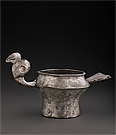Exhibition themes Inca
The Inca Empire only lasted 100 years, a short time for such a vast and famous enterprise. The Incas conquered all Peru and much of Chile, Bolivia, Argentina and Ecuador. The state, ruled by the divine Sapa Inca, governed from the capital city Cuzco by a system of duties, taxes and rewards. 20,000 kilometres of roads enabled efficient and speedy communication. The royal family's name was given to the culture they created. Their Quechua language was the lingua franca throughout the empire, surviving the Spanish invasion of 1532–33; it is still spoken today.
The emperor was the son of the Sun God and the pinnacle of an extremely hierarchical society. The Inca state religion demanded sacrifices, human and animal—even textiles were burnt as offerings to the gods. Architecture, such as that found at the famous World Heritage Site Machu Picchu, was the glory of Inca culture: temples, palaces, terraces and fortifications of huge stone blocks were fitted together, mostly without masonry. Almost all Incan metalwork was stolen by the conquistadors and melted down for coins.
Our knowledge of Inca society is filtered through the worldview of Spanish chroniclers. The Inca state of at least 12 million people fell very rapidly, due to superior European military technology, civil war and introduced diseases, especially smallpox. Perhaps 90 per cent of the native population, more than 10 million people, was killed or died of disease and famine after the conquest.







![| Urpu [Aryballos jar] | 1400-1533 AD](images/sml/236014.jpg)
![| Urpu [Aryballos jar] | 1400-1533 AD](images/sml/236147.jpg)
![| Kero [Ceremonial cup] | 1400-1533 AD](images/sml/236009.jpg)
![| Unku [Tunic] with a 'tocapus' pattern | 1400-1533 AD](images/sml/236004.jpg)


![| Unku [Tunic] | 1400-1533 AD](images/sml/236005.jpg)
![| Urpu [Aryballos jar] | 1400-1533 AD](images/sml/236013.jpg)